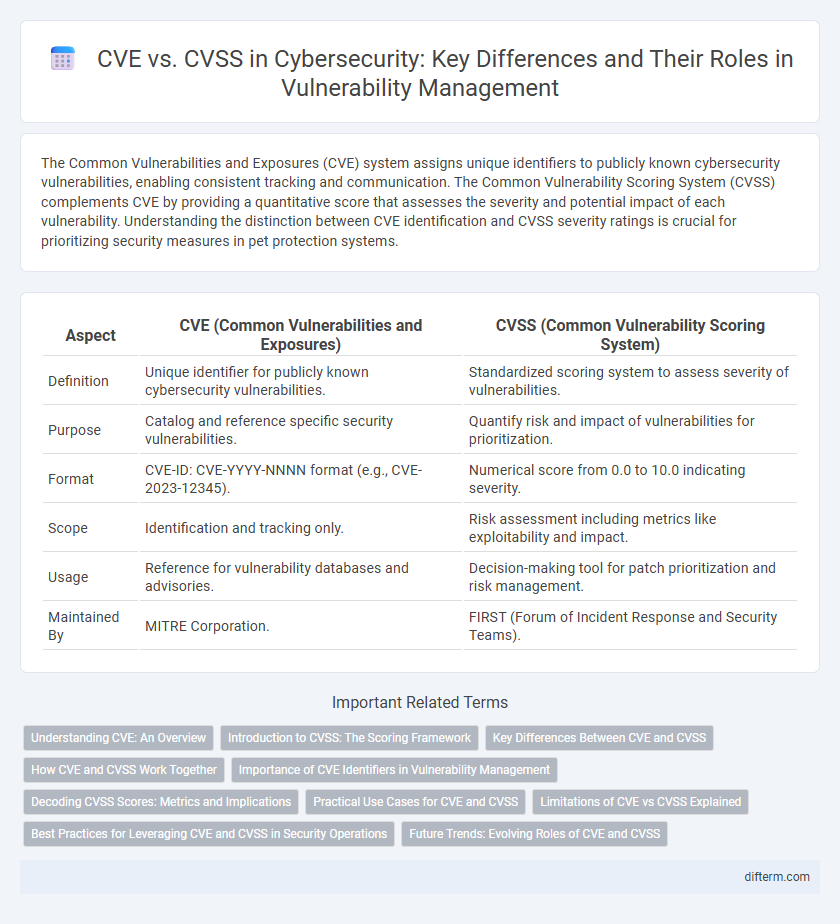The Common Vulnerabilities and Exposures (CVE) system assigns unique identifiers to publicly known cybersecurity vulnerabilities, enabling consistent tracking and communication. The Common Vulnerability Scoring System (CVSS) complements CVE by providing a quantitative score that assesses the severity and potential impact of each vulnerability. Understanding the distinction between CVE identification and CVSS severity ratings is crucial for prioritizing security measures in pet protection systems.
Table of Comparison
| Aspect | CVE (Common Vulnerabilities and Exposures) | CVSS (Common Vulnerability Scoring System) |
|---|---|---|
| Definition | Unique identifier for publicly known cybersecurity vulnerabilities. | Standardized scoring system to assess severity of vulnerabilities. |
| Purpose | Catalog and reference specific security vulnerabilities. | Quantify risk and impact of vulnerabilities for prioritization. |
| Format | CVE-ID: CVE-YYYY-NNNN format (e.g., CVE-2023-12345). | Numerical score from 0.0 to 10.0 indicating severity. |
| Scope | Identification and tracking only. | Risk assessment including metrics like exploitability and impact. |
| Usage | Reference for vulnerability databases and advisories. | Decision-making tool for patch prioritization and risk management. |
| Maintained By | MITRE Corporation. | FIRST (Forum of Incident Response and Security Teams). |
Understanding CVE: An Overview
CVE (Common Vulnerabilities and Exposures) serves as a standardized identifier system for publicly known cybersecurity vulnerabilities, facilitating clear communication and tracking across different platforms and organizations. Each CVE entry provides concise information about a specific security flaw, helping security professionals prioritize and coordinate their response efforts. Understanding CVE is essential for effective vulnerability management, as it lays the groundwork for risk assessment tools like CVSS (Common Vulnerability Scoring System).
Introduction to CVSS: The Scoring Framework
The Common Vulnerability Scoring System (CVSS) provides a standardized framework to evaluate the severity of security vulnerabilities, allowing organizations to prioritize mitigation efforts effectively. CVSS quantifies vulnerability characteristics through Base, Temporal, and Environmental metrics, producing a score ranging from 0 to 10 that reflects potential impact and exploitability. This scoring system enhances vulnerability management by translating Common Vulnerabilities and Exposures (CVE) listings into actionable risk assessments.
Key Differences Between CVE and CVSS
CVE (Common Vulnerabilities and Exposures) identifies and catalogs publicly known cybersecurity vulnerabilities with unique identifiers, enabling consistent reference across security tools. CVSS (Common Vulnerability Scoring System) quantifies the severity of these vulnerabilities through a standardized scoring system ranging from 0 to 10 based on metrics like exploitability and impact. While CVE provides the identification framework, CVSS offers a numerical risk assessment to prioritize vulnerability remediation efforts.
How CVE and CVSS Work Together
CVE (Common Vulnerabilities and Exposures) provides unique identifiers for publicly known cybersecurity vulnerabilities, enabling consistent tracking and communication across platforms. CVSS (Common Vulnerability Scoring System) complements CVE by assigning severity scores to these vulnerabilities, which helps organizations prioritize risk remediation efforts based on exploitability and impact metrics. Together, CVE identifiers offer precise vulnerability identification while CVSS scores guide decision-making in vulnerability management and patch prioritization.
Importance of CVE Identifiers in Vulnerability Management
CVE identifiers provide a standardized and unique reference for each publicly known cybersecurity vulnerability, enabling efficient tracking and communication across security tools and teams. Unlike CVSS, which quantifies the severity of vulnerabilities, CVE ensures consistent identification and correlation in vulnerability management databases. This unique identification system is crucial for timely patching, prioritization, and comprehensive threat intelligence integration.
Decoding CVSS Scores: Metrics and Implications
Decoding CVSS scores involves understanding its base, temporal, and environmental metrics that quantify the severity and impact of vulnerabilities. The Common Vulnerability Scoring System (CVSS) assigns numerical values that guide prioritization and mitigation strategies, contrasting with CVE's role in identifying and cataloging vulnerabilities. Accurate interpretation of CVSS scores enables security teams to assess risk levels effectively and allocate resources for vulnerability management.
Practical Use Cases for CVE and CVSS
CVE (Common Vulnerabilities and Exposures) provides a standardized identifier for publicly known cybersecurity vulnerabilities, enabling organizations to track and reference specific threats effectively. CVSS (Common Vulnerability Scoring System) assigns numerical scores to these vulnerabilities, aiding security teams in prioritizing remediation efforts based on severity and potential impact. Practical use cases include CVE for vulnerability identification in asset inventories and vulnerability databases, while CVSS guides risk management decisions and resource allocation during incident response.
Limitations of CVE vs CVSS Explained
CVE (Common Vulnerabilities and Exposures) provides unique identifiers for known security vulnerabilities, but it lacks a standardized severity rating system, limiting its ability to assess risk comprehensively. CVSS (Common Vulnerability Scoring System) addresses this gap by offering a scalable and quantifiable score reflecting the severity and potential impact of each vulnerability, facilitating better prioritization. However, CVSS scores may not capture all context-specific factors such as exploit availability or environmental conditions, requiring complementary analysis for effective security risk management.
Best Practices for Leveraging CVE and CVSS in Security Operations
Effective security operations integrate CVE and CVSS by using CVE to identify and catalog vulnerabilities accurately, while leveraging CVSS scores to prioritize response based on severity and exploitability metrics. Best practices include continuously updating CVE databases for comprehensive vulnerability awareness and utilizing CVSS base, temporal, and environmental metrics to tailor risk assessments according to organizational context. Automating the correlation of CVE identifiers with CVSS scores enhances patch management efficiency and accelerates mitigation strategies.
Future Trends: Evolving Roles of CVE and CVSS
CVE identifiers will increasingly integrate machine learning algorithms to enhance vulnerability detection accuracy and speed, facilitating real-time updates in response to emerging threats. CVSS scoring is evolving to incorporate environmental and temporal factors, enabling dynamic risk assessments aligned with specific organizational contexts. Emerging standards aim to unify CVE and CVSS frameworks, promoting seamless interoperability and automated remediation workflows across cybersecurity platforms.
CVE vs CVSS Infographic

 difterm.com
difterm.com